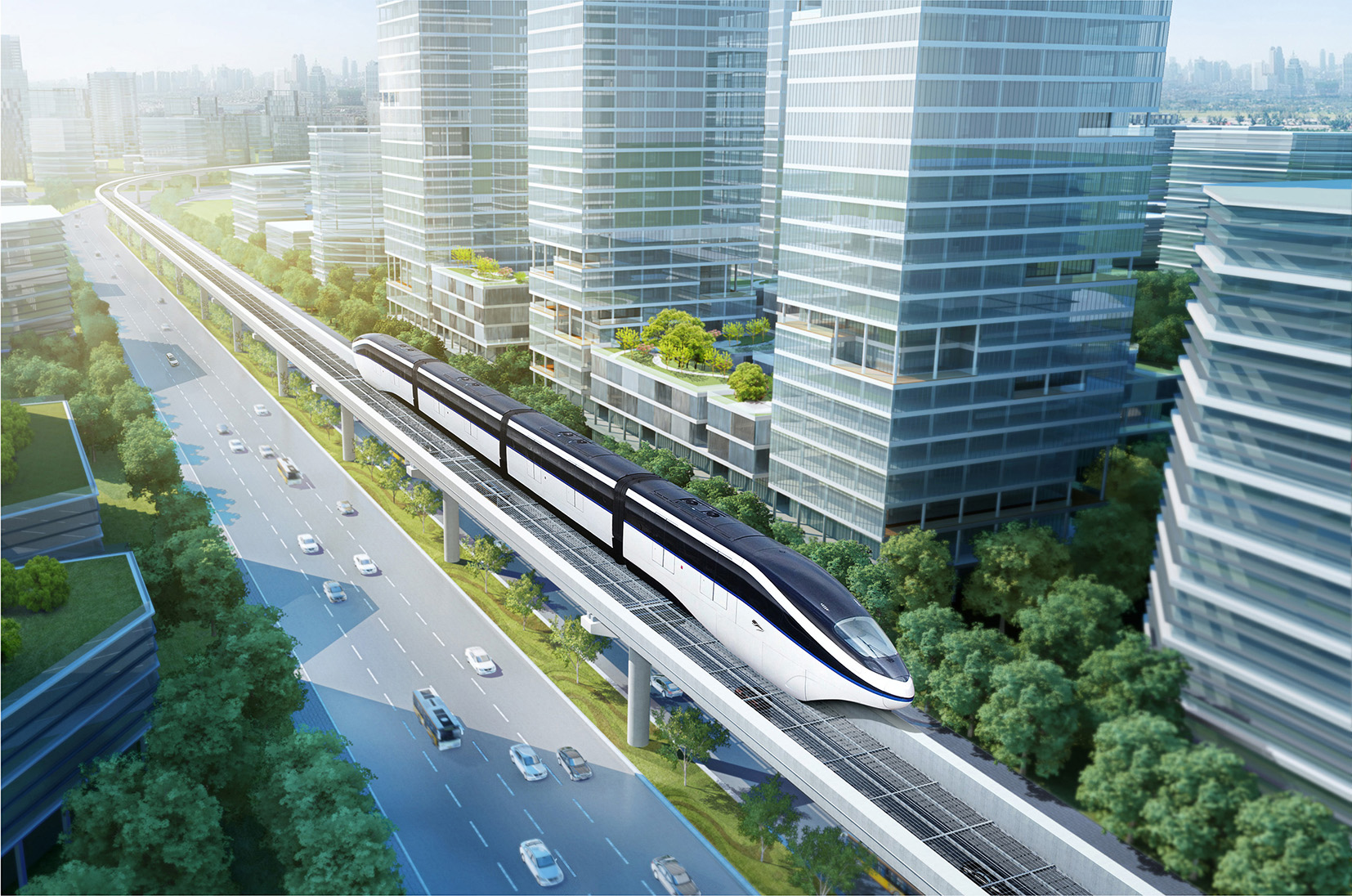
Local Team,
global Solution
LA SKYRAIL EXPRESS
SkyRail technology is sweeping the globe and will provide a fast, safe, lower cost transportation solution over a 15 mile stretch of the Sepulveda Pass connecting Expo Line, UCLA/Westwood and the San Fernando Valley with 8 to 9 high-tech stations to enhance how Angelenos travel across Western LA County.
The facts speak for themselves
The type of mass transit that SkyRail represents is a preferred transit option across the globe – from Germany, England, Italy, Singapore, Japan, China, Australia, Brazil, and locally in Seattle, Las Vegas and New Jersey to countless other successful systems. Currently there are 42 cities around the world totaling 269 miles, with over 400 stations carrying millions of passengers each day. SkyRail is far lighter, less costly, faster/easier to construct than comparable elevated structures required by traditional rail vehicles – increasing mobility options for a more sustainable future. The advantages of SkyRail operating in the I-405 median will include minimizing disruption to communities and making it a visible option that encourages taking public transportation.

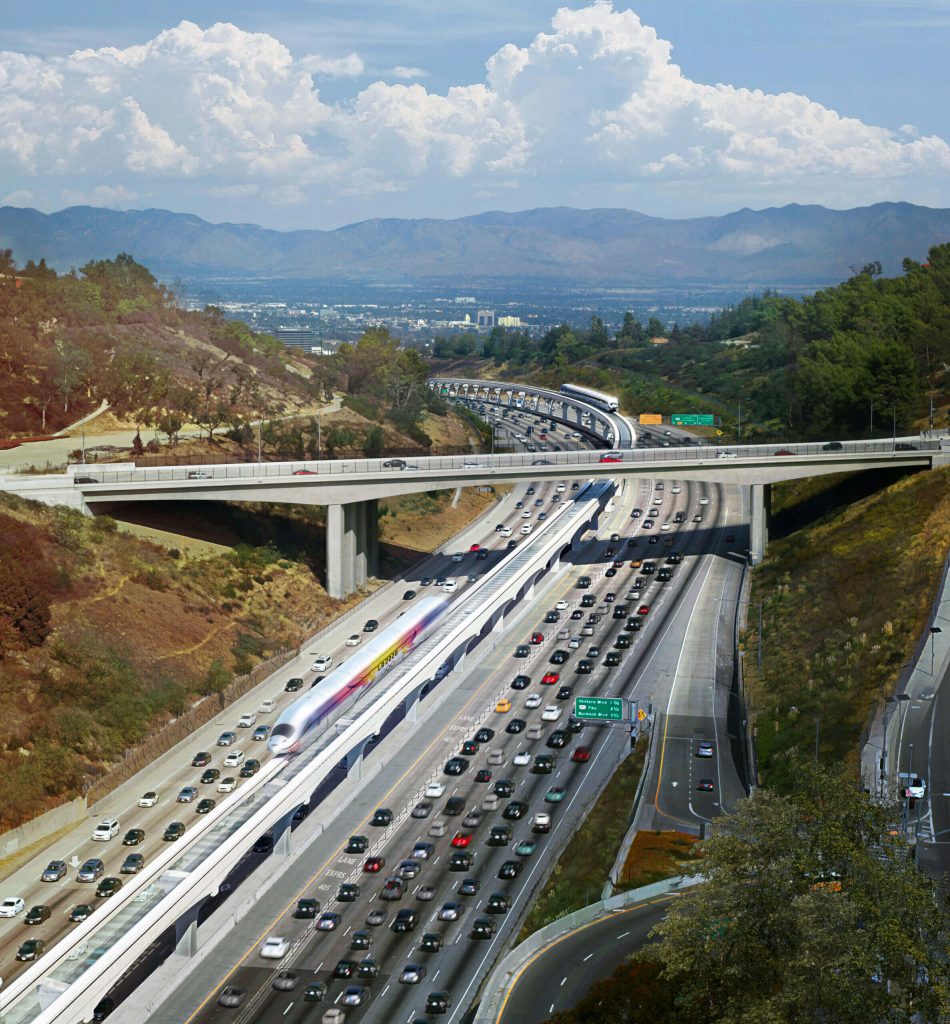
SkyRail is compelling alternative for the Sepulveda Corridor
To realize our vision for the Sepulveda Transit Corridor (STC) Project, LASRE is advocating the most modern and state-of-the-art transit technology intended for dense urban environment. SkyRail is the world’s most advanced driverless, straddle-type monorail system, representing the state-of-the-art monorail technology that has evolved over nearly 60 years from an amusement park ride to a service proven, high-capacity, sustainable, urban rapid transit solution — a technology family that has become the new system of choice in several of the world’s largest modern cities, including São Paulo, Bangkok, Cairo, Tokyo and Chongqing, all of which already had Heavy Rail Transit (HRT).
Where SkyRail WILL take me
UCLA/WESTWOOD
Recognizing the importance of connectivity to UCLA, the SkyRail alignments were developed with input from UCLA stakeholders and each of the SkyRail alternatives facilitate connectivity to serve this important destination. SkyRail alternatives would provide a new transit connection from the main alignment to UCLA via electric bus, elevated SkyShuttle (APM), or an underground monorail within the main route.
ACROSS THE SEPULVEDA PASS
SkyRail will provide a much-needed alternative to the heavily-traveled Sepulveda Pass, where over 400,000 people travel each weekday between the LA Basin and the San Fernando Valley through the 405 freeway and Sepulveda Blvd to get across the Santa Monica Mountains.
SAN FERNANDO VALLEY
The San Fernando Valley is home to a multitude of residences, employment centers and destinations. SkyRail will be linking thousands of people who live, work and play in the San Fernando Valley at four future stations: Ventura Blvd, Metro G Line, Sherman Way and the Van Nuys Metrolink Station.
SkyRail checks all the boxes
The LA SkyRail Express project concept alternatives that are currently under consideration meet Metro’s stated parameters for capacity, speed, and service frequency objectives for the Sepulveda Transit Corridor project.

METRO HAS ESTABLISHED SIX GOALS
- Improve mobility
- Improve accessibility and promote equity
- Support community and economic development
- Protect environmental resources and support a sustainable transportation system
- Provide a cost-effective solution and minimize risk
- Enhance resiliency
Visit metro.net/projects/sepulvedacorridor/
THREE ALTERNATIVES FOR SKYRAIL
All three alternatives are almost identical with the exception of how UCLA is served.
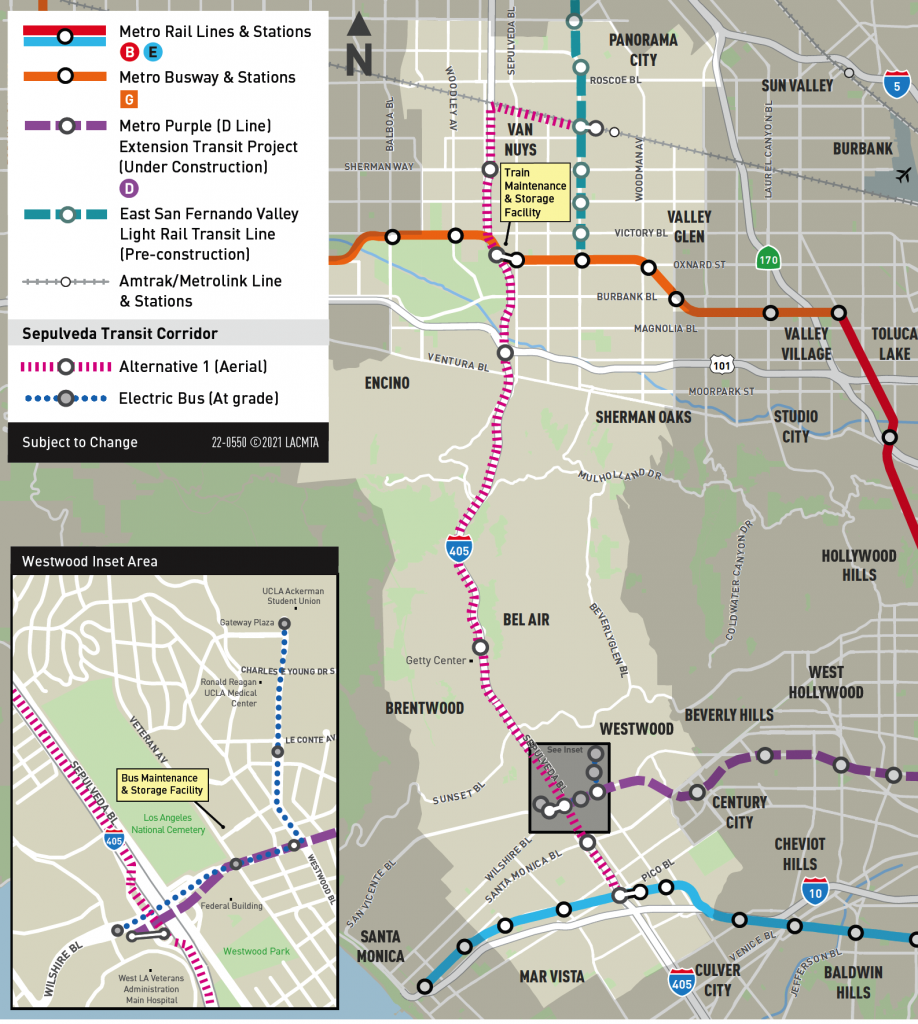
ALTERNATIVE 1
Alternative 1’s mainline SkyRail stop here will be west of the I-405 with a planned pedestrian connection to the VA Station. Riders would transfer and board a new dedicated fleet of low-floor, battery-electric buses to provide frequent service to and from the mainline and the center of the UCLA campus in the Luskin Center area.
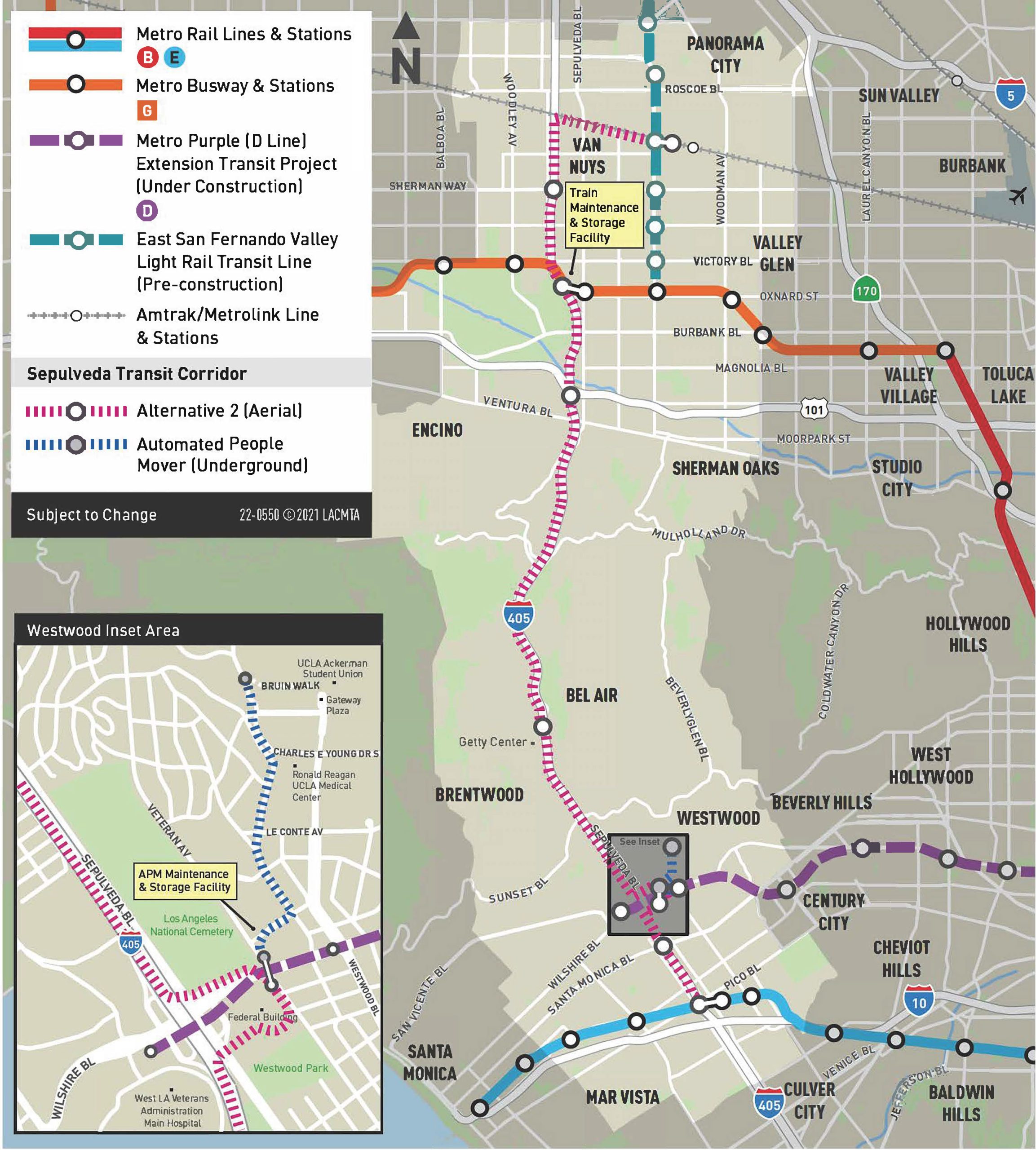
ALTERNATIVE 2
The SkyRail project team developed Alternative 2, which includes an aerial alignment for a new automated people mover (APM) using state-of-the-art battery electric SkyShuttle technology to provide a high-frequency, ecologically sustainable (as per BYD vehicle specifications) connection to and from the mainline with two stations located on the western side of the UCLA campus (Lot 36) and in the Pauley Pavilion and Dykstra Hall area. The transfer between the SkyRail mainline and the high service frequency APM would occur at Wilshire Blvd and Veteran Ave, near or on UCLA Lot 36.
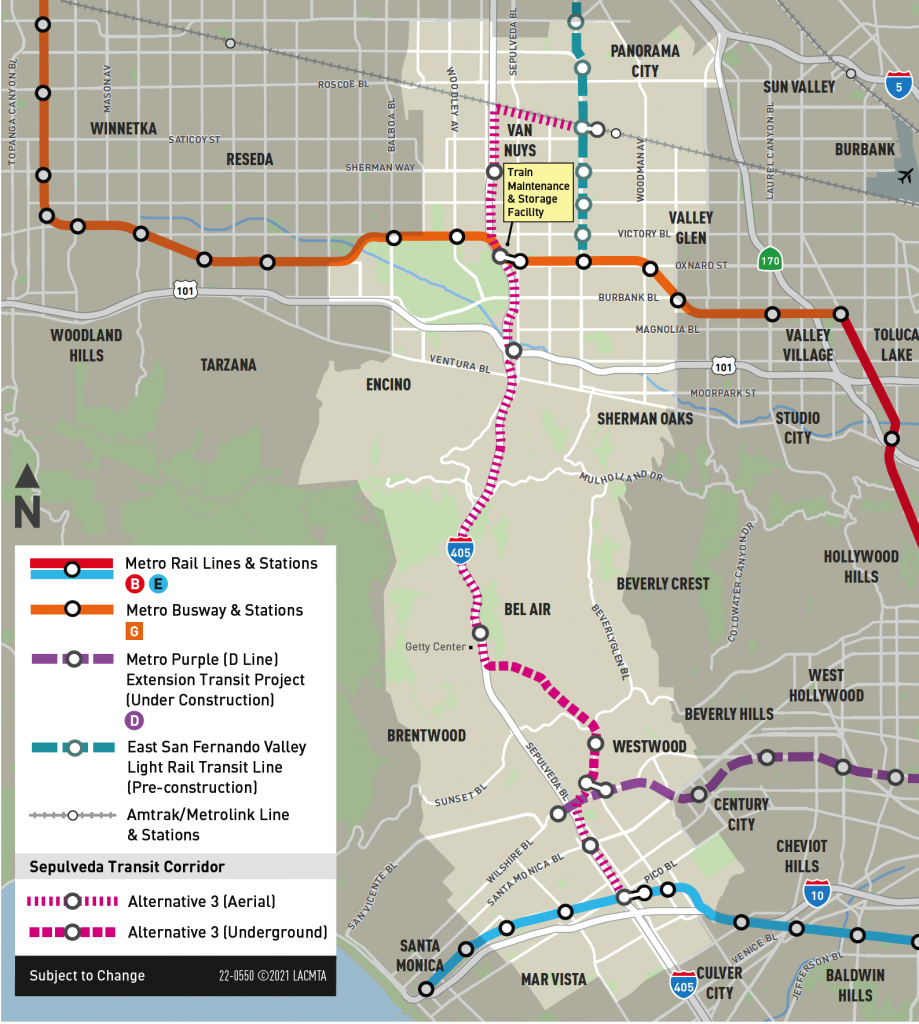
ALTERNATIVE 3
An underground tunnel alignment from the Getty Center Station to UCLA was developed as Alternative 3. This alternative would include an underground station adjacent to the Luskin Center, and an underground station along the western side of Lot 36 at the Wilshire Boulevard (Metro D [Purple] Line) Station.
SkyRail will meet the demand
2 minutes headway would provide capacity of nearly 19,000 passengers per hour per direction, greater than Metro’s requirement for 12,000 passengers per hour per direction.
SkyRail would provide a peak line capacity of nearly 19,000 passengers per hour per direction. At their current scheduled headways, the Metro Red and Purple Lines provide only a fraction of the peak line capacity required for the Sepulveda Transit Corridor. SkyRail can also operate on a 90-second headway that would further increase the line capacity without the need to expand the vehicle or length the station platforms.
SkyRail would operate at 65mph (with a higher speed capability of up to 75 mph), with a 24-minute end-to-end travel time.
From the Van Nuys Metrolink Station to the Exposition Boulevard (Metro E [Expo] Line) Station, the end-to-end travel time for the SkyRail Alternatives are estimated at 24 minutes (inclusive of a 30-second dwell time in each station). In the future, the extension of SkyRail Alternatives from the San Fernando Valley to the LAX Station is estimated at 30 minutes (inclusive of station dwell times).
The network capacity required for the Sepulveda Transit Corridor (STC) is well within the capability of this technology. As a matter of fact, monorail projects across the globe are in commissioning stages for 45,000 per person per hour per direction, and more.
Though not currently under study, the Sepulveda Transit Corridor is intended to be extended further south at a later date. SkyRail’s alternatives are designed to accommodate future extension south to the South Bay area, including Los Angeles International Airport (LAX), consistent with Metro’s Measure M expenditure plan. The connection from West Los Angeles at the D (Purple) Line to LAX has a projected opening date of 2057, per the Measure M ordinance. Implementation of a new transit connection to LAX also corresponds to Phase 3 of the Sepulveda/Interstate 405 Corridor Improvement Project.
Depending on the alternative that is selected, we are looking at 8 or 9 SkyRail stations (aerial stations on the shoulder of the 405 with the exception of UCLA station in alternative 3).
Typically SkyRail, projects cost 20%-50% less when compared to underground heavy rail transit options.” Underground heavy rail transit options are generally more expensive and amplified by cost escalation during extended construction periods.
SkyRail is a smart alternative
The SkyRail project team anticipates that the implementation of the SkyRail alternatives will create tens of thousands of jobs during construction. In 2017, The American Public Transit Association (APTA) estimated that rapid transit construction generates an average of 13,210 jobs per $1 billion of expenditure (combining both construction and manufacturing jobs). This equates to up to 123,500 jobs related to construction and manufacturing. To the maximum extent possible, and to align with the requirements of Buy America, new jobs will be sourced from local communities with specialized training, and with close partnerships with organized/union labor.
SkyRail operates with more energy efficiency than any other form of other rail alternatives.
- Trains are roughly 30% lighter, resulting in less energy needed to propel the SkyRail.
- SkyRail alternatives include containerized, rechargeable, long-life batteries configured in energy storage facilities that are highly safe & efficient in capturing the energy generated by the electric motors when trains decelerate. Studies have estimated that this factor alone can reduce energy consumption by up to 30%.
- Trains are streamlined and thereby create less wind resistance.
- The structures are lighter, and their simple design elegance requires far less resources and energy to construct – and to maintain. Therefore, the lifecycle energy demand is compellingly lower
SkyRail is a rubber-tired straddle-type monorail that has substantially less emitted noise & vibration than any steel-wheeled guided transit technology. Furthermore, the vehicles are equipped with side skirts that cover the tires, which further reduce noise emissions. By operating mostly within the I-405 median, the incremental noise effect of the monorail will be negligible as compared to the existing ambient freeway noise. System noise and vibration, along with potential mitigations are being fully studied as part of the environmental clearance process.
SkyRail vehicles are roughly 30% lighter per foot as compared to the typical heavy rail transit subway cars. SkyRail vehicles use much lighter weight structural frames than traditional rail vehicles. This is because the traditional rail vehicle frames must support the very heavy “trucks, or bogies” that contain the steel wheels and electric motors. To the contrary, SkyRail vehicles typically are much lower profile because they actually do “straddle” the guide beams, and because they do not require those large and very heavy bogies. There is also no need for heavy steel tracks needed for other traditional guided transit systems. SkyRail structural engineers estimate that the monorail structure requires roughly half the concrete and steel. This then translates to further cost, and environmental benefits not possible by non-monorail transit systems.
Local project team with a proven track-record
The LA SkyRail Express project team is led by:
- John Laing: Equity Member and the leading Public-Private Partnership (P3) transit project developer in North America.
- BYD: Equity Member, Technology Supplier and Systems Integrator, Co-Lead Operation & Maintenance (O&M) Contractor, and the world’s leading supplier of electric transportation products and vehicles.
- Skanska: Lead Construction Contractor and one of the world’s top Design & Build contractors.
- Keolis: A global leader in the mass transit O&M domain.
- HDR: Lead Engineer and one of America’s largest employee-owned engineering firms.
- Gensler: Lead Architect and one of the world’s largest and most respected design firms.
- Innova: Lead Structural Engineer and a certified DBE firm that provides specialized monorail structural design.
Most of the member firms are either based in Los Angeles or have a longstanding and significant presence here. John Laing, BYD, Gensler, HDR and BYD have over 2,300 employees in Los Angeles County. Member firms include over 30 local Disadvantaged Business Enterprises.
